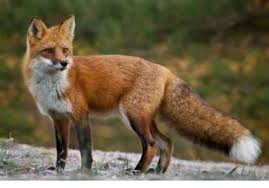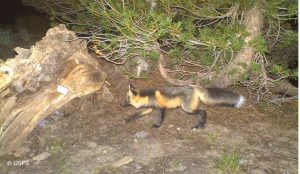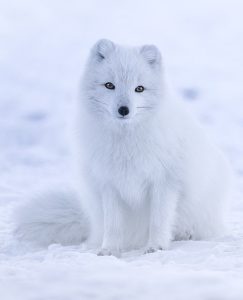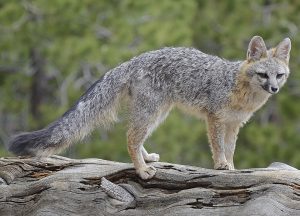Podcast: Play in new window | Download (Duration: 7:15 — 8.1MB)
Thanks to Katie, Torin, and Eilee for suggesting this week’s topic, foxes!
Further reading:
Meet the Endangered Sierra Nevada Red Fox
Long snouts protect foxes when diving headfirst in snow
Black bears may play important role in protecting gray fox
The red fox:

A black and gold Sierra Nevada red fox [photo taken from the first link above]:

The extremely fluffy Arctic fox:

The gray fox [photo by VJAnderson – Own work, CC BY-SA 4.0, https://commons.wikimedia.org/w/index.php?curid=115382784]:

Show transcript:
Welcome to Strange Animals Podcast. I’m your host, Kate Shaw.
This week we have an episode about foxes, a suggestion by Katie, and we’ll talk about fox species suggested by Torin and Eilee.
Foxes are omnivorous canids related to dogs and wolves, and just to be confusing, male foxes are sometimes called dogs. Female foxes are vixens and baby foxes are cubs or kits. But even though foxes are related to dogs and wolves, they’re not so closely related that they can interbreed with those other canids. Plus, of course, not every animal that’s called a fox is actually considered a fox scientifically.
The largest species of fox is the red fox, which also happens to be the one most people are familiar with. It’s common throughout much of North America, Eurasia, and the Middle East, and even parts of northern Africa. It’s also been introduced in Australia, where it’s an invasive species. It’s a rusty-red in color with black legs and white markings, including a white tip to the tail. It has large pointed ears and a long narrow muzzle.
There are lots of subspecies of red fox throughout its natural range, including one suggested by Eilee, the Sierra Nevada red fox. It lives in the Sierra Nevada and Oregon Cascades mountain ranges in the western United States, in parts of California, Nevada, and Oregon. It’s smaller than the red fox and some individuals are red, some are black and gold, and some are a mix of red and gray-brown. Its paws are covered with long hair that protects the paw pads from snow, and its coat is thick.
The Sierra Nevada red fox was first identified as a subspecies in 1937, but it took more than half a century until any scientists started studying it. It used to be common throughout the mountain ranges where it lives, but after more than a century of trapping for fur and shooting it for bounty, it’s one of the rarest foxes in the world. Fewer than 100 adults are known to survive in the wild, maybe even fewer than 50.
For a long time, scientists thought the Sierra Nevada red fox had been extirpated from California, and that it might even be completely extinct. Then a camera trap got pictures of one in 2010. It’s fully protected now, so hopefully its numbers will grow.
Torin suggested we learn about the Arctic fox, which lives in far northern areas like Greenland, Siberia, Alaska, and parts of northern Canada. The Arctic fox’s muzzle is relatively short and its ears are rounded, and it also has a rounder body and shorter legs than other foxes. This helps keep it warm, since it has less surface area to lose body heat.
During the summer, the Arctic fox is brown and gray, while in winter it’s white to blend in with the snowy background. There are some individuals who are gray or brown-gray year-round, although it’s rare. The Arctic fox’s fur is thick and layered to keep it warm even in bitterly cold weather, and like the Sierra Nevada red fox, it has a lot of fur on its feet.
The Arctic fox is omnivorous like other foxes, although in the winter it mostly eats meat. In summer it eats bird eggs, berries, and even seaweed along with fish and small animals like lemmings and mice. It also eats carrion from dead animals and what’s left from a polar bear’s meal. It has such a good sense of smell that it can smell a carcass from 25 miles away, or 40 km. Its hearing is good too, which allows it to find mice and other animals that are traveling under the snow. Like other foxes, it will poke its nose into the snow quickly to grab the little animal, an activity called mousing. A study from 2024 revealed that the fox’s snout shape helps keep it from getting injured in deep and compacted snow.
The grey fox lives throughout North and Central America, although it’s less common than it used to be due to habitat loss and hunting by humans. It’s a grizzled gray in color with reddish or tan legs, and a black stripe down its tail ending in a black tail tip.
It’s actually not that closely related to what are called true foxes. Its pupils are rounded like a dog’s instead of slit like other foxes, which have eyes that resemble cats’ eyes. The grey fox also has hooked claws that allow it to climb trees like a cat, and when it’s in a tree it can climb around in it just fine. A vixen may make her den in the hollow part of a tree to have her babies, sometimes as much as 30 feet, or 9 meters, above the ground, although most of the time gray foxes den on the ground, in a burrow, hollow log, or even in an abandoned human building.
The gray fox is small, not much bigger than a domestic cat, and it eats a lot of the same things that coyotes eat. If a coyote feels like a grey fox is encroaching on its territory, the coyote will kill the fox. Naturally, foxes are cautious around coyotes as a result. A study published in 2021 discovered that in areas where black bears live alongside coyotes and gray foxes, the foxes spend a lot of time hanging out near bears. In winter when the bears are hibernating, the foxes leave because coyotes will move into the area until the bears re-emerge in spring. Coyotes are afraid of bears, so the presence of bears protects the foxes as long as the fox doesn’t annoy the bear. I feel like this would make a great basis for a cartoon.
You can find Strange Animals Podcast at strangeanimalspodcast.blubrry.net. That’s blueberry without any E’s. If you have questions, comments, or suggestions for future episodes, email us at strangeanimalspodcast@gmail.com. We also have a Patreon at patreon.com/strangeanimalspodcast if you’d like to support us for as little as one dollar a month and get monthly bonus episodes.
Thanks for listening!